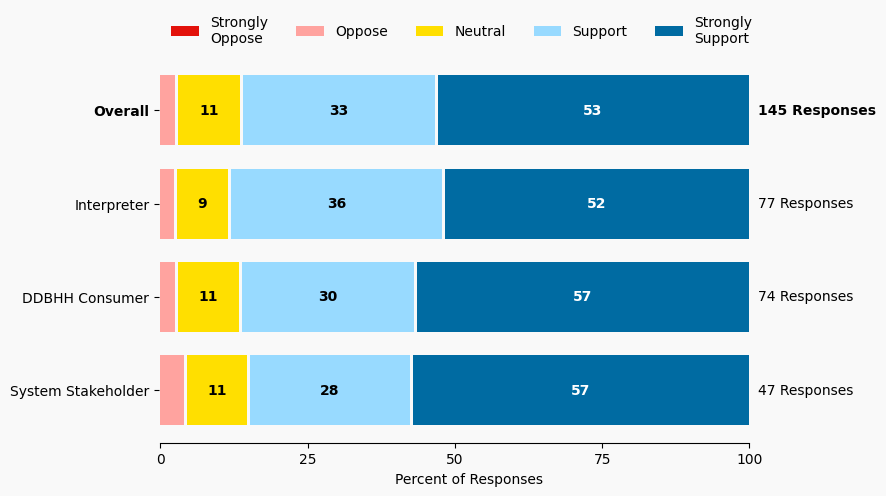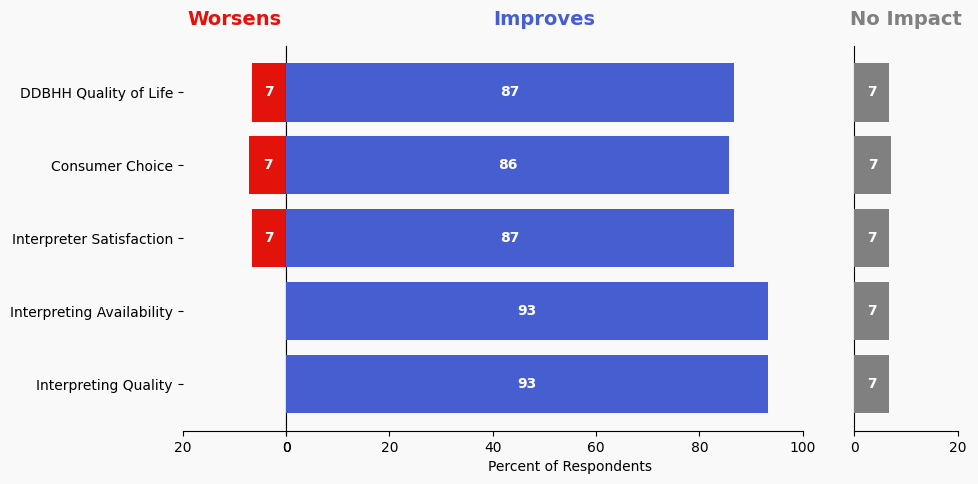14 Expand Deaf, DeafBlind and Hard of Hearing State Services Grants
Issue: There are multiple needs for interpreting supports to increase the quality and availability of interpreters, particularly in Greater Minnesota and for DeafBlind consumers.
Proposed Solution: State Services and coalition request greater funding to support interpreting demands in Minnesota. Currently, State Services has greatly beneficial grant programs – for example to support DeafBlind access, DDBHH consumers access for funerals and support groups and Greater Minnesota interpreters. However, more is needed to provide learning opportunities for prospective and current working interpreters. Additional funding is suggested for more internships, mentor programs, workshops and other professional development, stipends for interpreters seeking the BEI, scholarships for ITP students, and stipends for DDBHH people and interpreters going to career fairs and ASL classes to recruit interpreters.
Expected outcome: Increased quality and availability of interpreters; greater access for consumers statewide.
Who is impacted: Interpreters, consumers
Timeline: 6 months

Summary of Support Image Description
The stacked bar charts show how respondents rated their level of support and the total number of responses. The percentage for the five support levels is shown from left to right: Strongly Oppose (Dark Red), Oppose (Light Red), Neutral (Yellow), Support (Light Blue), and Strongly Support (Dark Blue).
Respondents may identify with multiple subgroups. The overall level of support is:
Overall
Strongly Oppose: 0%
Oppose: 3%
Neutral: 11%
Support: 33%
Strongly Support: 53%
Click to see the detailed image description for each subgroup.
Interpreter
Strongly Oppose: 0%
Oppose: 3%
Neutral: 9%
Support: 36%
Strongly Support: 52%
DDBHH Consumer
Strongly Oppose: 0%
Oppose: 3%
Neutral: 11%
Support: 30%
Strongly Support: 56%
System Stakeholder
Strongly Oppose: 0%
Oppose: 4%
Neutral: 11%
Support: 28%
Strongly Support: 56%
Overview of Respondents Opting for In-Depth Solution Analysis
After indicating their support level, 9% of the 145 respondents opted in to further assess whether the solution would worsen or improve on five metrics. Of the opt-in reviewers (14 respondents), 64% supported the solution, 14% were neutral on the solution, and 21% opposed the solution.
The remaining 131 respondents did not opt in to further assess the solution. Of these people, 88% support the solution, 10% were neutral on the solution, and 0% opposed the solution.
Reviewer Evaluation of Solution Effectiveness

Solution Effectiveness Image Description
The stacked bar charts show how respondents assessed the effectiveness of this solution based on five metrics. For each metric, the percentage of respondents is shown from left to right: Worsens (Red), Improves (Blue), No Impact (Gray).
DDBHH Quality of Life
Makes It Worse 6%
Makes It Better 86%
No Impact 6%
Interpreter Satisfaction
Makes It Worse 6%
Makes It Better 86%
No Impact 6%
Consumer Choice
Makes It Worse 7%
Makes It Better 85%
No Impact 7%
Interpreting Availability
Makes It Worse 0%
Makes It Better 93%
No Impact 6%
Interpreting Quality
Makes It Worse 0%
Makes It Better 93%
No Impact 6%
Reviewer Feedback and Insights
Interpreter
Comments from Interpreters express concerns about the distribution of grants, especially in Greater Minnesota (GM), where there may not be enough demand to justify more funding. One comment suggests expanding grants to support interpreters in the metro area, as they are currently underserved.
Deaf, DeafBlind, Hard of Hearing
Comments from DDBHH Consumers highlight that State Services grants could play a significant role in addressing issues, particularly funding-related ones. One comment expresses concerns about transparency in monitoring how grantees use the funds, and emphasize the importance of maintaining the Deaf ecosystem and focusing on the specific needs of deaf communities when awarding grants.
System Stakeholder
Comments from System stakeholders support the potential of State Services grants to address key funding issues.
PREVIOUS SOLUTION
13 Require All Major Local News Services to Provide Picture-in-Picture Interpreters
Issue: DDBHH Minnesotans do not all have clear access to news in the local communities where they live.
NEXT SOLUTION
15 Create a Central State Government Interpreting Services Office
Issue: Burden on individual state agencies for interpreting costs; no central state model of excellence in interpreting. With the One Minnesota campaign, the philosophy falls short and penalizes entities with DDBHH employees, as well as penalizes state agencies that have to pay for interpreting services.
Leave a Reply